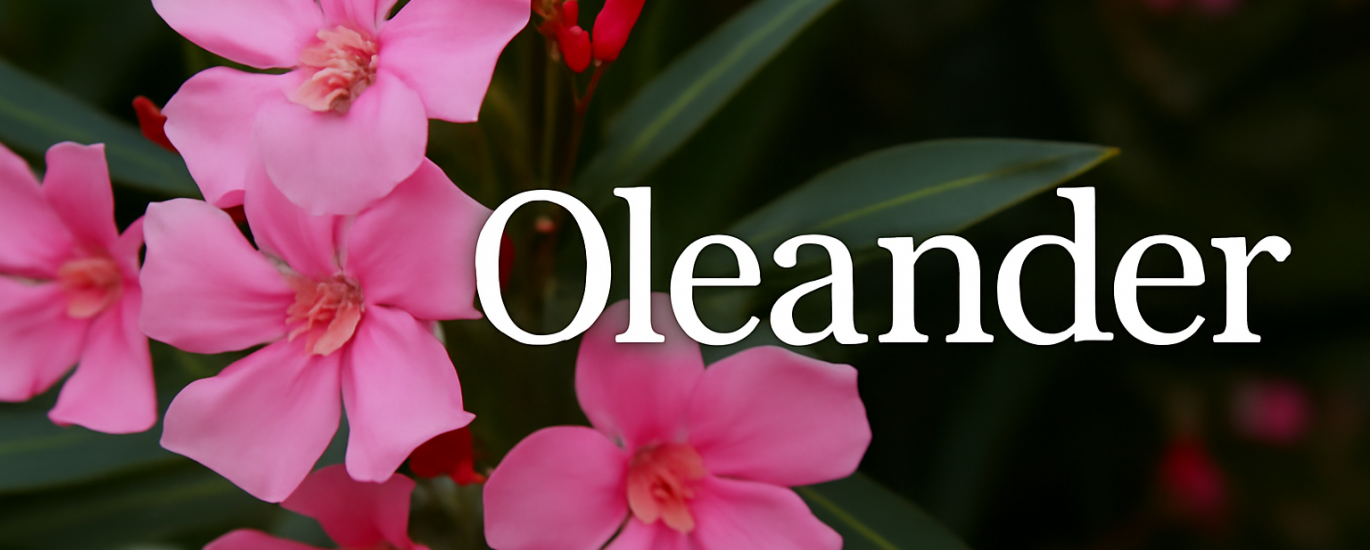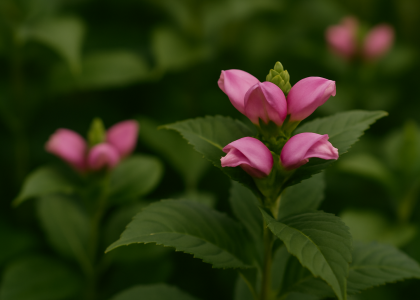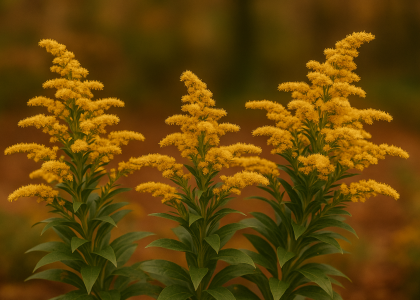Oleander (Nerium oleander) is a striking, evergreen shrub known for its showy, colorful flowers and its ability to thrive in hot, dry conditions. Whether you're looking to add a vibrant touch to your garden or create a low-maintenance hedge, Oleander is an excellent choice. This hardy plant is a favorite for gardeners in warmer climates due to its beauty, hardiness, and long-lasting blooms. However, despite its low-maintenance nature, Oleander does require some care to thrive. In this guide, we will explore how to plant, care for, and propagate Oleander, along with expert tips to ensure it flourishes in your landscape.
What is Oleander?
Oleander is a flowering shrub native to the Mediterranean and Asia. It is known for its abundant, colorful flowers, which come in shades of white, pink, red, and yellow. The plant’s dense, evergreen foliage makes it an excellent choice for creating privacy screens or hedges. Oleander can grow up to 6 to 12 feet tall, with some varieties reaching even greater heights, making it a versatile addition to your garden. It thrives in warm climates (USDA Zones 8-10) and is highly resistant to drought and pests, but it is also highly toxic to humans and animals if ingested, so it must be handled with care.
Key Features of Oleander:
- Flower Color: White, Pink, Red, Yellow
- Foliage Color: Dark green, glossy
- Height: 6 to 12 feet (varies by variety)
- Width: 4 to 10 feet
- Blooming Season: Late Spring through Fall
- Hardiness Zones: 8-10
- Special Features: Drought-tolerant, low-maintenance, highly toxic (handle with care), attracts pollinators
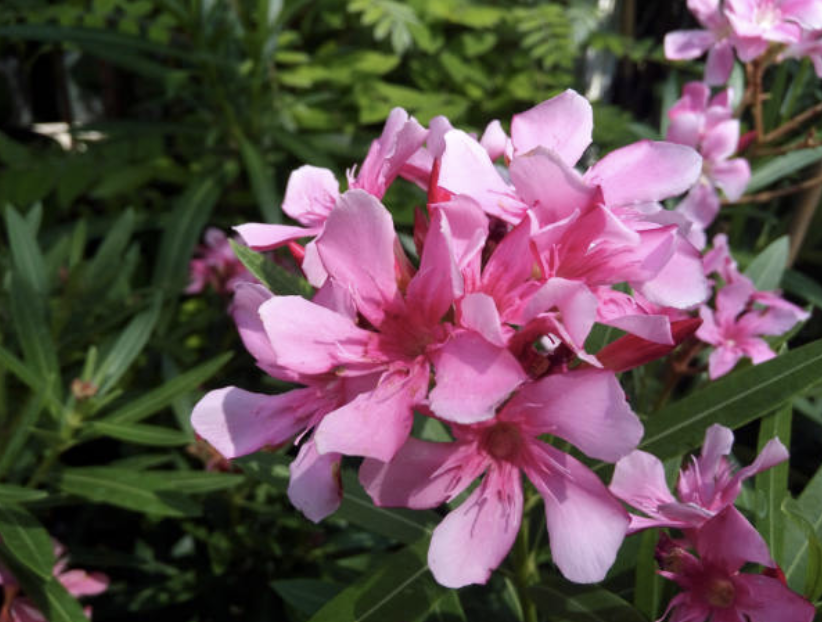
Where to Plant Oleander
Oleander is a sun-loving plant that thrives in full sun. It requires well-draining soil and benefits from being planted in a location that offers protection from cold winds, especially in regions near the colder end of its hardiness range. It is perfect for gardeners in warmer climates but can also be grown in containers in cooler regions and brought indoors during winter.
Ideal Planting Locations:
- Privacy Screens and Hedges: Oleander is an excellent choice for creating a fast-growing privacy screen or hedge due to its dense, upright growth habit.
- Border Planting: Plant Oleander along garden borders to add a splash of color and year-round greenery.
- Arid and Xeriscape Gardens: Its drought tolerance makes it a perfect candidate for xeriscaping and low-water-use landscapes.
Expert Tip: In colder climates (Zones 8), plant Oleander in a sheltered location near a south-facing wall or patio to protect it from late frost and cold winds.
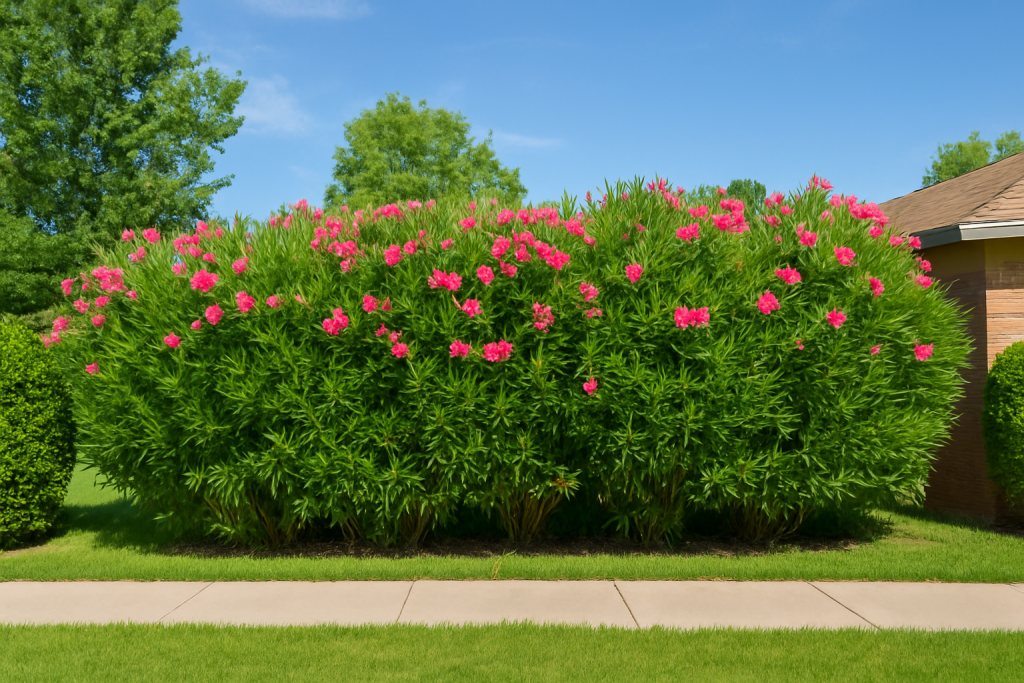
How to Plant Oleander
Oleander is relatively easy to plant and care for. Following the proper planting guidelines will ensure your plant thrives and blooms profusely.
- Best Time to Plant: Oleander should be planted in early spring or early fall, avoiding the hot summer months.
- Planting Hole: Dig a hole that is twice the size of the root ball and slightly deeper. Make sure the top of the root ball is level with the surrounding soil.
- Soil: Oleander grows best in well-draining soil, whether sandy or loamy. It can tolerate poor soil, but good drainage is essential to prevent root rot.
- Mulching: Apply a 2-inch layer of mulch around the plant’s base to help retain moisture and suppress weeds, particularly during the first year after planting.
Expert Tip: Oleander is tolerant of poor soil but thrives when given a slightly acidic to neutral pH. It is also highly drought-tolerant once established.
Oleander Care: Keeping Your Plant Thriving
Oleander is known for being a low-maintenance shrub, but to ensure it thrives and blooms for years, consider these care tips:
Light Requirements:
Oleander needs full sun to bloom well and produce the vibrant flowers it is known for. Aim for at least 6 hours of direct sunlight daily. It will tolerate some shade but may produce fewer flowers.
Watering:
Oleander is highly drought-tolerant once established. However, newly planted shrubs should be watered regularly to help them establish strong roots. Once the plant is mature, it can withstand long dry spells, but it will benefit from deep watering during prolonged drought periods.
Expert Tip: Water deeply but infrequently once the plant is established, allowing the soil to dry out between waterings to prevent waterlogged conditions.
Soil and Fertilizer:
Oleander prefers well-draining soil but can adapt to most soil types. It does not require much fertilizer, but a light application of a balanced fertilizer in early spring can promote strong growth and abundant blooms.
Expert Tip: Avoid over-fertilizing, as this can lead to excessive leaf growth at the expense of flowers. A slow-release fertilizer in early spring will provide the necessary nutrients without overstimulating the plant.
Pruning Oleander
Pruning is important for maintaining the shape and health of Oleander. Follow these tips for successful pruning:
- When to Prune: Prune Oleander in early spring before new growth begins. Avoid heavy pruning in fall or winter, as this could leave the plant vulnerable to cold damage.
- How to Prune: Remove dead or damaged branches first. If the plant is getting too large, cut back one-third of the oldest branches to promote fresh growth. Oleander can be shaped as a small tree or hedge depending on your preferences.
Expert Tip: Always wear gloves when pruning Oleander, as all parts of the plant are toxic if ingested or handled improperly.
Pests and Problems
Oleander is generally resistant to pests and diseases, but it can occasionally face a few issues:
- Aphids: Small pests that may appear on new growth. Spray with insecticidal soap or a strong water stream to remove them.
- Oleander Caterpillar: This pest can defoliate the plant. Hand-pick or use Bt (Bacillus thuringiensis) to control the caterpillars.
- Fungal Diseases: Oleander can suffer from mildew or root rot if the soil does not drain well. Avoid overwatering and ensure good air circulation.
Expert Tip: Regularly inspect Oleander for signs of pests, especially in the spring and summer when new growth is most vulnerable.
Propagation: How to Grow New Oleander Plants
Oleander is easily propagated by stem cuttings. Follow these steps to grow new plants:
- Take Cuttings: In late spring or early summer, cut a 6-8 inch section from a healthy Oleander stem, just below a leaf node.
- Prepare the Cuttings: Remove the lower leaves and dip the cut end in rooting hormone to encourage rooting.
- Rooting: Place the cutting in a pot filled with well-draining soil. Keep the soil moist but not waterlogged, and place the pot in a warm, shaded area. In a few weeks, the cutting should develop roots.
Expert Tip: Oleander cuttings root quickly in warm, humid conditions. Keep them in a humidity dome or cover the pot with plastic to maintain moisture.
Types of Oleander
There are several varieties of Oleander, each offering unique flower colors and growth habits:
- ‘Petite Pink’: A dwarf variety with pink flowers, growing up to 3 feet tall. Ideal for small gardens or containers. Zones 8-10.
- ‘Hardy Red’: A cold-hardy variety with deep red flowers. Grows up to 6 feet tall. Zones 7-10.
- ‘Variegatum’: Known for its white and green variegated leaves and white flowers with a hint of pink. Grows up to 8 feet tall. Zones 8-10.
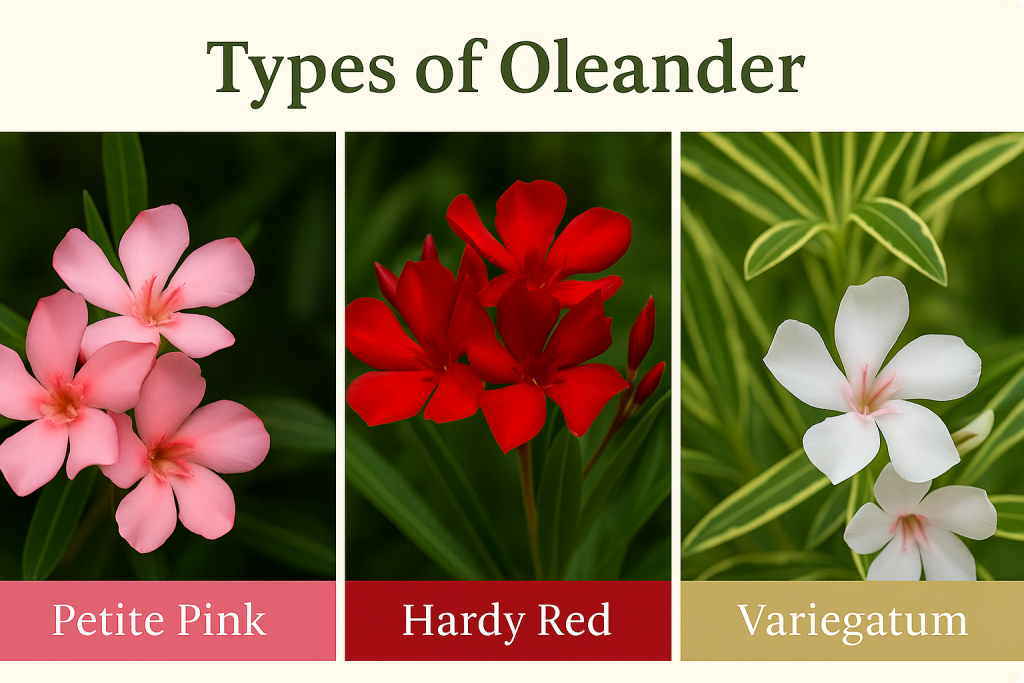
Companion Plants for Oleander
Oleander pairs well with other heat-tolerant, low-maintenance plants:
- Lavender: The fragrant purple flowers and aromatic leaves contrast beautifully with Oleander’s colorful blooms.
- Russian Sage: A drought-tolerant shrub that provides a nice contrast to Oleander’s vibrant flowers.
- Lantana: The bright, multi-colored flowers of Lantana complement Oleander’s blooms in a sunny, low-maintenance garden.
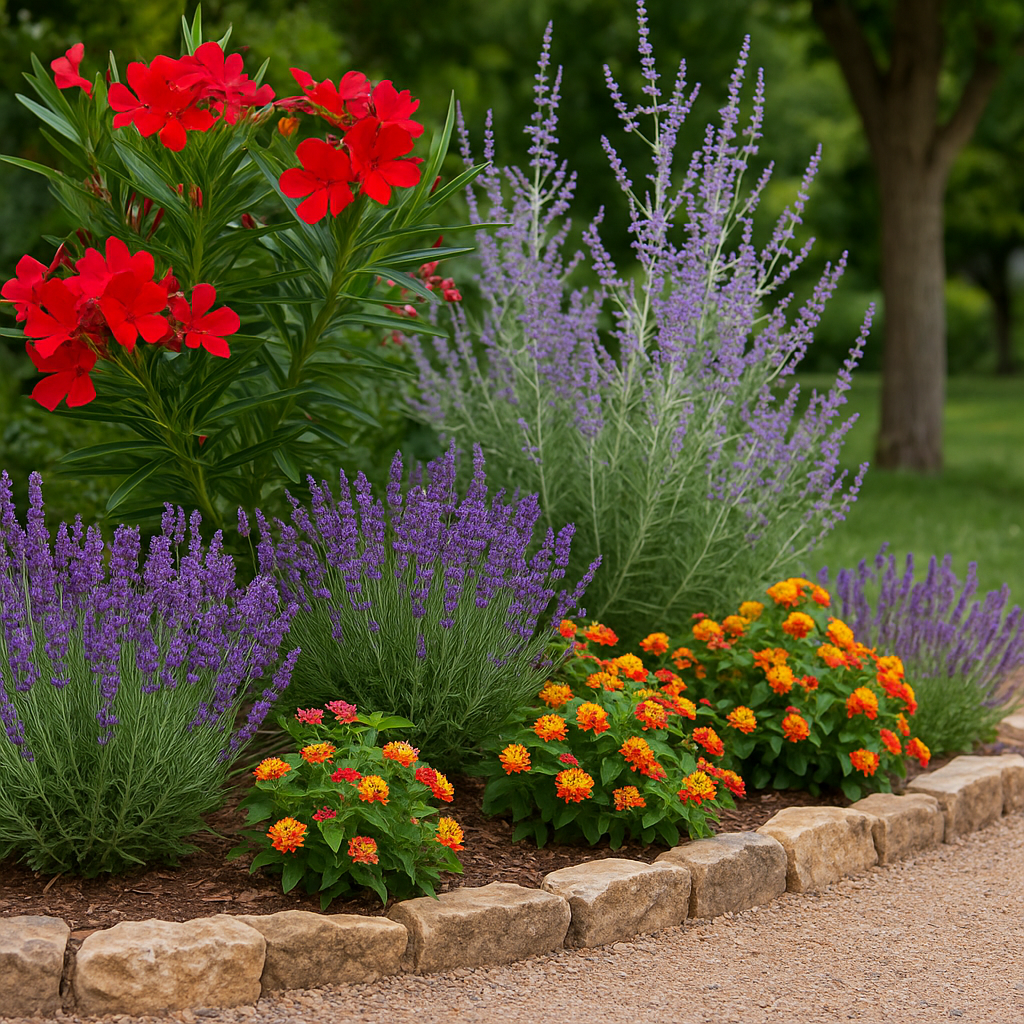
FAQ: Common Oleander Questions
Is Oleander toxic to pets and humans?
Yes, all parts of Oleander are highly toxic if ingested, including the leaves, flowers, and stems. Ensure that children and pets do not have access to this plant.
Why isn’t my Oleander blooming?
Oleander needs full sun and well-drained soil to bloom profusely. If it is planted in too much shade or overwatered, it may not bloom well. Also, avoid heavy pruning in late fall or winter.
Enjoy Oleander in Your Garden
Oleander is an ideal choice for gardeners looking for a hardy, low-maintenance shrub that thrives in sunny, hot climates. With its vibrant flowers, glossy foliage, and drought tolerance, Oleander is a standout in the garden, offering beauty year-round with minimal effort. By following the tips in this guide, you can enjoy a healthy, thriving Oleander plant that brings color and life to your landscape.

